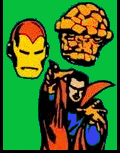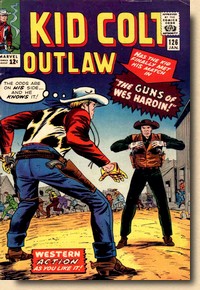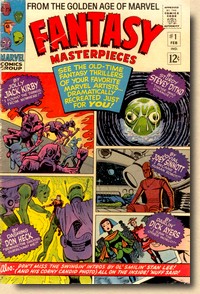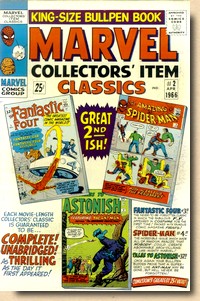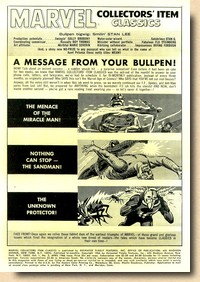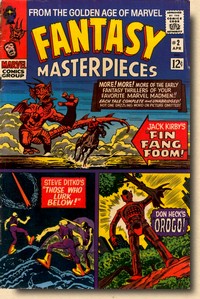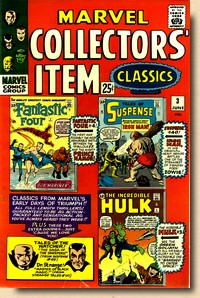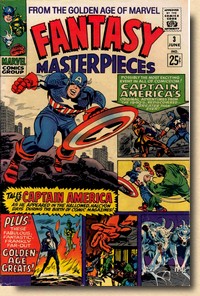| |
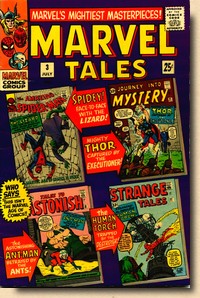
Marvel
Tales #3
(July 1966)
|
|
The changes
made to Fantasy
Masterpieces weren't the
only alterations Marvel applied
to its steadily growing range of
full reprint titles. The next
makeover happened when the third
issue of Marvel Tales Annual went
on sale on 5 April 1966
- this time around simply as Marvel
Tales #3.
Still spread
out over 64 interior pages, the
title was now to be published
bi-monthly as well - which no
longer made it an Annual.
No changes
were, however, made to the
content formula, which still
consisted of reprinting four
superhero titles - in this case Amazing
Spider-Man #6 (originally
published with a cover date of
November 1963), the Human Torch
feature from Strange Tales
#101 (October 1962), the Thor
story from Journey
Into Mystery #84 (September
1962), and the Ant-Man adventure
from Tales
to Astonish #38 (December
1962).
|
|

Marvel
Tales #3
(July 1966)
|
|
|
|
| |
| |
KING-SIZE AND BI-MONTHLY
|
| |
| By mid-1966, Martin Goodman
and Stan Lee had found, tested and established their
reprint formula: king-size titles with 64 pages and
published bi-monthly for 25¢. Annuals still carried some new
original content along with reprint material (e.g. Sgt
Fury Annual #2, August 1966, featured one new story
and two reprints), as did the regular Western titles
(with their reprint backup stories). But in terms of
dedicated reprint titles, Marvel now had a clear-cut
publishing strategy.
|
| |
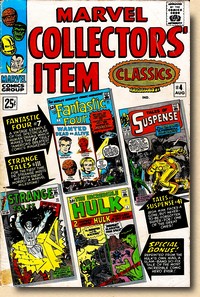
Marvel
Collectors' Item
Classics #4 (August 1966)
|
|
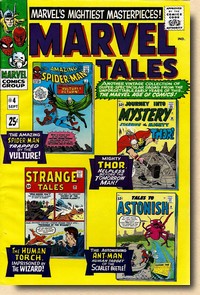
Marvel
Tales #4
(September 1966)
|
|
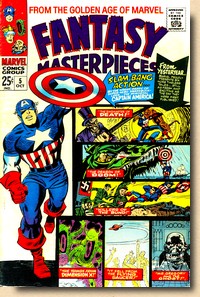
Fantasy
Masterpieces #5
(October 1966)
|
|
Marvel
Collectors' Item Classics
and Fantasy Masterpieces
were slated for the same
bi-monthly publishing slot (e.g.
August) while Marvel Tales would
be put out in the month between
(e.g. September). In terms of
content, Marvel Collectors'
Item Classics and Marvel
Tales continued to feature
reprints of four issues, while Fantasy
Masterpieces continued to
feature 1940s Captain America
reprints with Atlas era Sci-Fi
monster stories mixed in.
|
|
|
|
| |
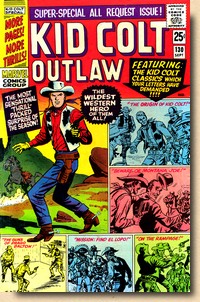
Kid
Colt Outlaw #130
(September 1966)
|
|
Gradually Fantasy
Masterpieces started adding
other 1940s superhero material
which included the Sub-Mariner
and the original Human Torch,
thus living up to its cover
banner "From the Golden
Age of Marvel". Putting out
previously published material as
king-size bi-monthlies was such a
business success that it even led
to an oddity.
Kid Colt
Outlaw #130 was originally
compiled as an annual for the
September 1966 cover date slot (as can be
seen from the style of box in the
upper left hand corner of the
cover), with 64 pages going for a
cover price of 25¢ and
featuring previously published
material only - but then somehow
someone changed their mind and Kid Colt
Outlaw #130 was put out as
simply another king-size
bi-monthly reprint title.
This
continued for another two issues,
until Kid Colt Outlaw #133
(March 1967) reverted back to a
regular 12¢ title
(with, again, new material plus a
reprint backup story).
Interestingly enough, none of the
reprints were marked as such at
all other than the (vague)
indication in the cover blurb.
|
|
|
|
| |
By mid-1966 Marvel's comic
book operations had expanded to the point where Martin
Goodman's office space at 625 Madison Avenue just got too
cramped, so he moved Stan Lee and all the bullpen down
the block to number 635.
"Goodman stayed
behind with his magazines; from now on, Stan Lee
would have a little more room to breathe, a little
less attention from the boss." (Howe, 2012)
|
| |
| |
BRANCHING OUT AND
REPACKAGING
Stan Lee's
growing freedom at the editorial reigns of Marvel Comics
would start to show rather quickly, and even more so as a
reported total annual sale of 33 million comic books
provided him with even more "good business"
leverage towards Goodman - proudly trumpeted in the May 1966 Bullpen Bulletin by quoting an article in the National
Observer which also mentioned fan readers setting up
chapters of the Merry Marvel Marching Society at Harvard,
Yale and Princeton.
|
| |
And things were only
about to get bigger as a growing media
diversification took place in late 1966.
First off, Marvel joined rival DC on
television.
"Marvel
super-heroes on TV! Here's the
official scoop so far - our first
stations will begin showing animated
films of five - yep, FIVE - of our
Marvel heroes in the middle of
September. The characters to be
featured will be: Captain America,
Iron Man, Thor, Sub-Mariner, and the
Hulk - all in full color! What's
more, we'll use exactly the same art
and stories which have made our mags
the sensation of the nation!
Production is under way right now, at
the famous Grantray-Lawrence
Animation Co. in Hollywood." (October 1966
Bullpen Bulletin)
|
|
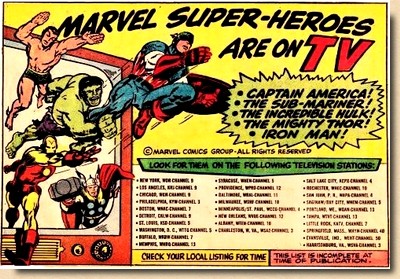
|
|
|
| |
| A major visibility push for
Marvel's comic books and characters, the resulting 65
half-hour episodes (comprising a total of 195 7-minute
segments, which initially ran in broadcast syndication
from September 1st to December 1st1966)
were produced with very limited animation using
photocopied images taken directly from the comics and
manipulated to minimize the need for animation
production. Not surprisingly, the result feels very close
to the actual comic books, and while contemporary viewers
didn't much approve of it, they have plenty of charm for
today's nostalgic viewers. But TV wasn't all - the October 1966 Bullpen Bulletin featured a lengthy list of
merchandising products, including records packaged with
actual comic books and paperback books. The latter were a
result of a cooperation between Marvel and Lancer Books
and featured black and white reprint material (from Fantastic
Four #1, #6, #11, #31 and Fantastic Four
Annual #2) which was reformatted to fit the paperback
size. As with regular paperback novels, this
"Collector's Album" was emblazoned with
critical acclaim from respected newspapers such as The
Village Voice and The New York Herald Tribune,
as well as testimonial voices from Yale and the
University of Chicago. Spider-Man, the Hulk and Thor
would get the same treatment in 1966, followed by
Daredevil and a second FF book in 1967 (Bagnall, 2014).
|
| |
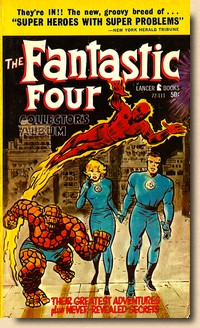
Fantastic
Four Collector's Album (Lancer
Books, 1966)
|
|
Although
obviously outside the scope of
actual reprint titles, both the
animated series and the Lancer
books show just how adept Marvel
had become at repackaging and
reselling existing material.
Returning to
comic books proper, Marvel
introduced another full-reprint
title in October 1966.
Marvel
Super-Heroes #1 was another
king-size offering featuring
reprints of Avengers #2
(originally published for the
November 1963 cover date
production), Captain America
#3 (May 1941), Daredevil
#1 (April 1964) and Marvel
Mystery Comics #8 (June
1940). Although announced as a
quarterly, it would remain a
one-shot - at least for the time
being.
Coming full
circle with Marvel's media
diversification of 1966, Marvel
Super-Heroes #1 is often
seen as a tie-in to the animated
series, which obviously carried
the same title. However, given
the line-up of the TV series and
the comic book there is little
evidence to support that view.
Also, the Bullpen Bulletins
of 1966 mentioned both the series
and the comic book, but never in
conjunction.
|
|
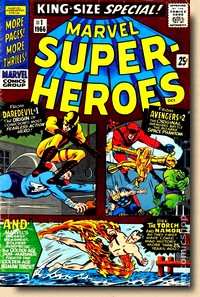
Marvel
Super-Heroes #1
(October 1966)
|
|
|
|
| |
| |
POSITIVELY
REPRINT
Marvel
Comics were in full swing, and Stan Lee clearly
enjoyed the added editorial freedom which came as
a benefit of commercial success and his boss not
being in the same office anymore.
"At
the top of our hectic heap sits the
king-of-the-hill, Merry Marty Goodman,
publisher, and peerless purveyor of profound
policy, pulsating plaudits, and palpable
pay-checks! When he speaks, we listen! When
he frowns, we tremble! When he smiles, we
know that somewhere one of you had bought
another Marvel mag!" (December 1966 Bullpen
Bulletin)
As far
as the reprint titles were concerned, this
resulted in a change of terminology. Whereas
Goodman's business sense, honed in the 1940's and
1950's paperback novel market, told him to avoid
the word "reprint" by all means, Lee
had a different approach. Yes, it was selling old
wine in new skins, but that wine was marketed as
a vintage Grand Cru.
|
|
| |
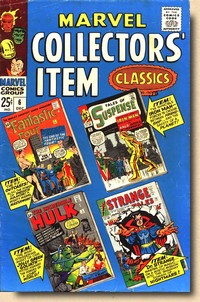
Marvel
Collectors' Item
Classics #6 (December 1966)
|
|
For Stan Lee,
it truly was all about content,
and so he started using the word
"reprint" more freely -
with his usual spin, of course,
as in Marvel Tales #4
where the contents were "reprinted by
popular demand". At the same
time, the king-size reprint
titles were increasingly labelled
as bargains - which from a
buyer's point of view wasn't
unreasonable.
1966 was also
the first year that the
"Alley Awards" (first
handed out in 1961) started
honouring the "best
all-reprint title" as well
as the "best combination new
& reprint material
title". The first was
snatched up by Harvey's The
Spirit, while the latter
went to Marvel's Fantastic
Four Annual.
Reprints had
definitely found a happy place
with both the industry and the
fans, and Marvel's role in this
was highly prominent.
Annuals
continued to combine new original
stories with classic reprint
material: Thor Annual #2
(September 1966) ran a 30-page
original story and two reprints
from Journey Into Mystery
#96 and #103, while Spider-Man
Annual #3 (November 1966)
featured a 21-page original story
and two reprinted regular stories
from Amazing Spider-Man
#11 and #12.
|
|
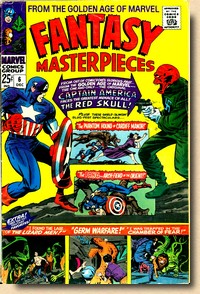
Fantasy
Masterpieces #6
(December 1966)
|
|
|
|
| |
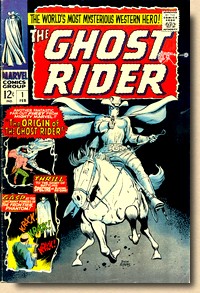
The
Ghost Rider #1
(February 1967)
|
|
Basically the
same formula was applied when a
new bi-monthly western title was
launched as part of the February
1967 cover month production: The
Ghost Rider #1 contained new
material and a reprint backup
story from Kid Colt Outlaw
#105 (July 1962) - the by now
standard editorial procedure for
all of marvel's western titles.
The Ghost
Rider only lasted for seven
issues before being cancelled
again in November 1967. Based on
a pre-comics code character by
Magazine Enterprises and
reimagined by Marvel when the
copyright lapsed, the Ghost Rider
(who
was retroactively renamed Night
Rider when Marvel used the name
for its motorcycle hero in 1973)
infused the western theme with a
touch of the supernatural. In a
similar approach to broaden the
genre, the regular western titles
saw an increasing number of
masked bad guys who had a slight
or even pronounced super-villain
touch (such as the
"Scorpion" from Rawhide
Kid #57).
|
|
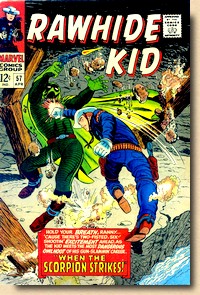
Rawhide
Kid #57
(April 1967)
|
|
|
|
| |
| All
throughout 1967, the three king-size reprint titles Marvel
Tales, Marvel Collectors' Item
Classics and Fantasy Masterpieces continued
their bi-monthly publication schedule as well as their
established content formula, with Marvel Tales and Marvel
Collectors' Item Classics typically displaying the
four covers of the stories reprinted. |
| |
| |
"NOT A SINGLE
REPRINT" - TAKING A
STAB AT DC COMICS
|
| |
Of course Marvel wasn't the
only comic book publisher reprinting their own material.
In fact, Marty Goodman and Stan Lee had taken more than
just inspiration for their annuals from market leader DC
Comics. But as imitation is the highest form of
flattery (as 19th century
English author Charles Caleb Colton put it), Lee also
liked to throw in some ribbing,
"figuring
it would be fun for us to needle some of the outfits
who were older and bigger than we." (April 1968
Bullpen Bulletin)
|
| |
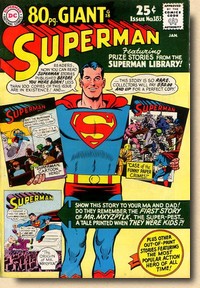
80
Page Giant Superman #G-18
(January 1966)
|
|
DC Comics had
dropped the Annual title
back in 1964 and turned their
80-pages reprint titles into an
ongoing series published nine
times a year. Called the 80
Page Giant Series it ran for
15 issues before the format then
continued into the pages of
several DC ongoing series which
gained the 80 Page Giant
heading in addition to their
regular title. Running for a
total of 93 issues the format was
dropped in August 1971. Unlike most
of Marvel's Annuals, DC's 80 Page
Giants mostly contained nothing
but reprint material, often
sourced from Golden Age issues
from the 1940s and 1950s. The
cover design was very similar to Marvel
Tales, Marvel
Collectors' Item Classics
and Fantasy Masterpieces,
but the difference in philosophy
between the two publishers is
summed up by the cover of 80
Page Giant Superman #G-18
(January 1966), where potential
readers are told to "show
this story to your Ma and
Dad!" and Superman
points out that "now you
can read Superman stories
published before you were
born!" - definitely
nowhere near as hip as being part
of the comic book revolution
called the Marvel Age of
Comics and reading up on its
classic stories from just a few
years back...
And as if
this wasn't enough already to
draw readers over to Marvel, Stan
Lee was about to stick another
finger in DC's eye.
|
|
|
|
| |
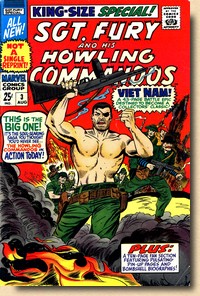
Sgt
Fury Special #3
(August 1967)
|
|
In mid-1967
Marvel dropped the label
"Annuals" as well, now
calling them "Specials"
- and marketing them as "All
New!" and containing "not
a single Reprint!" -
which is exactly what readers
got.

The first of
these Specials were Sgt Fury
Special #3 (on sale June 1st 1967 with an
August cover date) and Avengers
Special #1 (on sale July 11th 1967 with
the September cover date batch),
followed by the also "all
new, not a single reprint"
Amazing Spider-Man Special
#4 and Fantastic Four Special
#5, both on sale August 1st 1967 and
cover dated November 1967.
|
|

Avengers
Special #1
(September 1967)
|
|
|
|
| |

Marvel
Tales #10
(September 1967)
|
|
It was
another nifty marketing ploy to
make DC look bad - and headline
news in the September
1967 Bullpen Bulletin: whereas
readers got some rather stale
Golden Age material from the
"Distinguished
Competition" (as Stan
Lee at times liked to call DC
when he wasn't refering to them
as "Brand X")
for their 25¢, Marvel gave them
all brand-new stories. Of course
this came at a price, and the
additional creative workload
involved for writers and artists
who were already in overdrive at
times couldn't be sustained for
long - by 1969, Avengers
Annual #3 carried nothing
but reprints.
But
then Marvel didn't really need to
take additional shots at DC;
overall sales figures for 1967
showed that the House of Ideas
had overtaken DC and was now the
new industry leader.
"Thanks
to the loyalty of you
fabulous fans, and to the
hard work, talent, and
dedication of our beloved
Bullpenners, we've managed to
make ourselves the undisputed
leaders of the comic book
industry." (April
1968 Bullpen Bulletin)
Marvel Comics
sold just over 7 million copies
in 1967 (up from 6.6 million in
1966), whereas DC was down from
7.3 million copies in 1966 to 6.3
million in 1967.
|
|
|
|
| |
| Apart from the "no
reprints" Annuals/Specials in mid-1967, Marvel's
reprint titles kept to their appointed bi-monthly
publication schedules - until the December 1967 cover
date titles rolled around. |
| |
|
|
| |
|
| |
| BIBLIOGRAPHY BAGNALL
Bill (2014) "Marvel/Lancer
paperbacks (1966-67)", published online at 'Tain't
The Meat
DANIELS
Les (1991) Marvel: Five Fabulous Decades of
the World's Greatest Comics, Harry N. Abrams
HOWE
Sean (2012) Marvel Comics: The Untold Story,
Harper Collins
THOMAS
Roy (1998) "Stan the Man & Roy the Boy - A
Conversation Between Stan Lee and Roy Thomas", in
Comic Book Artist #2
|
| |
| |
The illustrations
presented here are copyright material.
Their reproduction for the review and
research purposes of this website is
considered fair use
as set out by the Copyright Act of 1976,
17 U.S.C. par. 107.

(c) 2019
|
|
|
|

